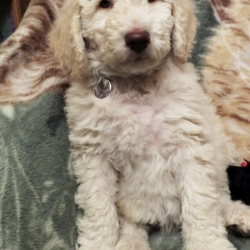


Separation Anxiety in Dogs is the second most common reason dogs are sent to a shelter. Unfortunately, some dogs never get out of the shelter, or have to be put to sleep because they are so scared of being alone, that they don’t become good household pets.
SUGGESTED METHODS TO HELP ALLEVIATE SEPARATION ANXIETY IN DOGS
SOME SIGNS OF SEVERE SEPARATION ANXIETY
a. Scratch marks or actual digging by the entrances of any doors leading out of the house.
b. Scratch marks at windows or on window sills.
c. Drooling in the front of the dog’s crate by the gate.
d. Drooling by the doorways or windows.
e. Destruction of blinds, draperies and woodwork indicates the dog may want to escape the house to look for you.
f. Destruction of household furnishings (e.g., torn sofa cushions).
g. Bowel excrement and urine anywhere in the house, including inside the crate. Sometimes dogs that are so severe might eliminate on walls and/or on furniture.
h. Crates that have openings where the dog has tried to get out of it.
i. Injuries that the dog might have inflicted upon himself, including wounds on his paws or other parts of his body done to reduce his own anxiety (akin to someone biting his nails).
j. Neighbors that complain about the dog barking for hours anytime he’s left alone.
k. Dog will not leave you alone for even a minute when you are home (aka Velcro Dog).

SOME SUGGESTED SOLUTIONS FOR REDUCING CANINE SEPARATION ANXIETY
1. Avoid making any fuss over your dog when greeting him after coming home from work or anytime you re-enter the home.
2. If the dog is able to remain safely in his crate during the time he’s left alone, give him a filled Kong toy or other high-value chewy to keep him occupied during your absence.
3. If your dog cannot stay safely in his crate without trying to escape it, or injure himself, try confining him to an area, such as the kitchen, using well-constructed baby gates or decorative metal gates high enough to prevent him from jumping out of it.
4. Put a radio or TV on to provide background noise so your dog won’t feel quite so alone and isolated during your absence.
5. If at all possible, ask a neighbor or a trustworthy teenager or professional pet sitter to stop by your house once or twice/day to give your dog a potty break and to take him for a walk or have a 1/2-hour play session with him.
6. Consider taking your dog to a doggy daycare center for one or two days/week, if that’s a possibility. Even though it may be a bit costly for just one or two days, it might actually save you money in repairing damages done by the dog, and it will save you some grief and aggravation because the dog will become happier and more self-confident.
7. Put your dog on a “Nothing in Life is Free Program” (aka “NILIF”). This is a benevolent program where structure and non-physical discipline provides predictability in the dog’s life.
8. AVOID PUNISHING THE DOG FOR ANY OF THESE BEHAVIORS! Your dog is already experiencing severe anxiousness, even though it might not be rational behavior in your mind. If you punish him, you will only increase the amount of anxiety he’s already feeling, and his behaviors might tend to worsen.
9. Make your routine of leaving the house varied so the dog cannot ever really know the exact time that you will be exiting the house.
10. Work hard on doing obedience training in a very positive fashion (e.g., clicker training or any reward-based training method that avoids any and all corrections or punishments). Obedience training will motivate your dog to do behaviors that please you. This will strengthen your leadership role with him, and it will also help him become more confident in both your ability to take care of yourself, and his ability to survive while being without you.
11. If your dog is showing severe SA behaviors, please discuss this at length with your veterinarian. There are pharmaceuticals he or she might recommend to help alleviate your dog’s feelings of stress and anxiety. One very common and popular drug used specifically for SA is called, “ Clomicalm
.” Here is a link to an article
you can take to your vet for his review.

I can say for a fact that in most of the SA cases that I’ve worked, the dogs improved greatly when the DAP diffuser was plugged in. But of course, it depends on how severe the situation is.
Purchase one or both of the following books: (a) The Canine Separation Anxiety Workbook , by James O’Heare or (b) I’ll be Home Soon: How to Prevent and Treat Separation Anxiety. , by Dr. Patricia McConnell. Both of these books are available at www.amazon.com
There are a few Yahoo group discussion lists on the web that deal with Separation Anxiety. You might benefit from subscribing to one or all of these lists to discuss your own issues and get advice from other owners who have experienced similar situations with their own dogs.
We have a Private Group on Facebook that's just for our Dreamydoodle Puppy Families
!
Plz Click Below to Join Us.. Please don't forget to answer the questions on the join request screen so our Admins know to accept your request!


Dreamydoodles.com, participates in various affiliate marketing programs. We may earn commissions on purchases made through links to carefully selected products we recommend. The commissions come at no extra cost to you and contribute to maintaining the quality of our website. Please be assured that our recommendations are based on thorough research, and your trust is of utmost importance to us. Thank you for supporting our commitment to providing valuable insights and information."